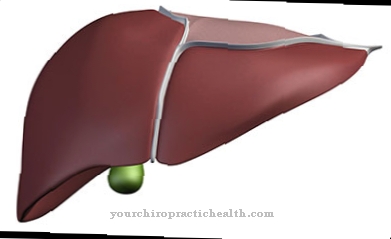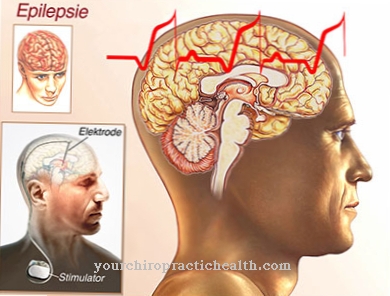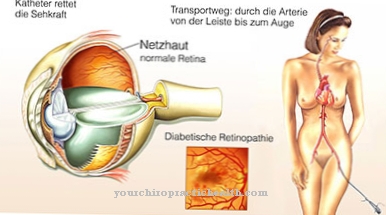The Trichodynia shows discomfort and sensation disorders in the form of tingling, itching, burning or pain on the scalp, which are usually associated with hair loss in the affected areas. However, no changes can be seen on the scalp. The cause is a tension in the skull muscles.
What is trichodynia?

© jim - stock.adobe.com
The term Trichodynia comes from the Greek and means "hair pain". However, it should be remembered that hair has no nerves and therefore cannot hurt. The actual area of pain, however, is the scalp. This is where hair loss usually occurs.
It often affects people who already have headaches, anxiety disorders or depression. A connection with stress and psychological stress was also found. Externally, no changes can be registered on the scalp. Since many doctors are not familiar with this clinical picture, the patient's complaints are often not taken seriously.
This phenomenon is often dismissed as a mental disorder. However, it has been shown that both genetic hair loss in men (androgenetic alopecia, AGA) and diffuse hair loss in both sexes (TE) can often be linked to trichodynia. As already mentioned, the symptoms worsen with stress or psychological stress.
causes
Tension in the muscles of the skull was recognized as the cause of trichodynia. This tension is often caused by stress, psychological stress or concentrated work on the computer. The skull is surrounded by flat muscles and tendons. There are the muscle groups of the occipital muscle (back of the head), the temporoparietalis muscle (on the ears) and the frontalis muscle (forehead).
All three muscle groups are networked with the scalp and, in addition to the hair roots, are supplied with nutrients and oxygen by the smallest blood vessels. The scalp stretches tightly over the roof of the skull, whereby its tension increases with concentration and psychological stress. This is reflected in the typical wrinkles that develop over time due to frequent, characteristic states of tension.
These include frown lines, crow's feet or horizontal forehead lines. The reason for this is the constantly increasing muscle tension. The severely tense scalp, however, compresses the fine arterial and venous blood vessels underneath and thus prevents certain areas from being adequately supplied with nutrients and oxygen. As a result, hair roots die and the hair falls out.
At the same time, due to the lack of oxygen in these regions, glucose can no longer be broken down properly. There is only a breakdown to lactic acid. Lactic acid or lactate builds up in the muscles, acidifies the muscles and causes pain. The effect of lactic acid on so-called sore muscles is known. The tingling and itching is caused by the increased excitation of the receptors of muscle, tendon and skin cells.
These excitations are also a result of the strong muscle tension. The constant pressure of the tense muscles also increases the irritation of the nerves. This stimulus activity in turn has an intensifying effect on the tension in the muscles. Ultimately, a vicious circle develops that is difficult to break without treatment.
Symptoms, ailments & signs
It has already been mentioned that trichodynia is characterized by pain, tingling (pins and needles) or itching on the scalp without any organic findings. There is no inflammation or infection in the affected area. In addition to the abnormal sensations on the scalp, the hair falls out in this area.
Both hereditary hair loss (androgenetic alopecia) and diffuse hair loss can be accompanied by trichodynia. Previous stressful situations, mental stress or previous mental illnesses such as depression or anxiety disorders are typical. The discomfort on the scalp does not go away by itself.
On the contrary, they cause further psychological stress, which makes the symptoms chronic. Many headache patients also often develop trichodynia. Certain types of headache are also caused by muscle tension.
Diagnosis & course of disease
Trichodynia can be easily diagnosed based on symptoms. The cause of the muscle tension should be determined through an extensive medical history. It is important to find out which specific stressful situations or previous mental illnesses are present. For treatment it is also important to know whether the underlying is lying hair disease is genetic or diffuse.
Complications
Trichodynia causes discomfort to the scalp in the patient. As a rule, those affected suffer from a very unpleasant tingling sensation or itching, which occurs directly on the scalp. The scalp itself is covered by infections or inflammation and can also be painful.
The hair can fall out, so that most of those affected also suffer from aesthetic complaints. This often leads to inferiority complexes or a significantly reduced sense of self-worth. Psychological complaints or depression also occur due to trichodynia. Furthermore, there are discomforts on the scalp. The patient's quality of life is significantly reduced by the disease.
As a rule, trichodynia can be treated relatively well with the help of medication. There are no complications or other complaints. The medication can also stop hair loss. However, it cannot be predicted whether the disease will be completely cured. In many cases, patients are therefore dependent on long-term use of the medication. However, trichodynia does not lead to a reduced life expectancy for the patient.
When should you go to the doctor?
Since trichodynia cannot heal itself, the person affected is definitely dependent on a medical examination and treatment. This is the only way to limit or prevent further complications or complaints, so that treatment by a doctor is essential. The earlier a doctor is consulted with trichodynia, the better the further course of the disease is usually. A doctor should be consulted with trichodynia if the person affected suffers from severe paresthesia on the scalp. This can lead to severe itching or hair loss.
The symptoms do not go away on their own and usually last longer. Headaches can also be caused by this disease. For trichodynia, a dermatologist or general practitioner can be seen. Treatment by a psychologist is not infrequently necessary, as this disease can also lead to depression or other mental disorders.
Treatment & Therapy
The treatment is based on relieving tension in the cranial muscles in order to provide the scalp and hair roots with sufficient nutrients and oxygen again. If this is achieved, the discomfort and pain as well as the hair loss can be partially reversed. The tingling, itching or pain in the scalp can be suppressed for several months.
In many cases, hair can grow again. In so-called AC therapy, muscle-relaxing drugs are administered. After two to three days, the tension will be released. As part of this therapy, relief or even the complete disappearance of the symptoms of trichodynia is almost always achieved.
The success of the treatment can last between four and seven months. However, since the effects of muscle relaxing medication are reversible, symptoms start again after this time. Then the therapy has to be repeated.
You can find your medication here
➔ Medication for hair loss and baldnessprevention
Avoiding stress is the primary recommended way of preventing trichodynia. During strenuous work on the computer or activities that require a lot of concentration, you should definitely take breaks to relax.
Aftercare
Follow-up care for trichodynia, like treatment, is based on the causal hair disease.If necessary, psychological disorders must also be included in the therapy and aftercare. In general, as part of the follow-up care, the inflammation that previously caused the patient symptoms is checked. If it has largely subsided, the doctor can still prescribe a mild pain reliever or an anti-inflammatory drug and then discharge the patient.
If trichodynia is based on psychological problems such as depression or anxiety disorders, the cause must be determined together with a therapist. Follow-up care for a mental illness is tedious and usually takes months or years. Depending on the underlying hair condition, one or more follow-up examinations may be necessary. After an acute inflammation, an examination is usually sufficient to assess the patient's state of health.
The dermatologist will check the scalp and especially the inflamed areas. If necessary, a tissue sample is taken which is then examined in the laboratory to determine typical causes such as an overproduction of substance P. If necessary, the patient can then be referred to a therapist, for example in the event of psychological complaints due to hair loss or skin changes. Follow-up care for trichodynia is carried out by the family doctor or a dermatologist.
You can do that yourself
Basically, it is advisable to consult a doctor in the event of trichodynia. This is especially true for patients who repeatedly suffer from the typical symptoms. Acute sufferers can relieve the hair, for example, by doing without a hat or by loosening braids. Some patients have had good experiences with oils that they rub into the scalp. Almond or olive oil are suitable.
Scientists agree that trichodynia is mostly triggered by psychological factors. These result from professional or private stress. It is therefore advisable to plan time off and avoid stress. Patients who permanently suffer from trichodynia should integrate alternative healing methods into their everyday lives. Autogenic training, for example, is suitable for this, in which deep inner calm and concentration is established. Acupuncture at a naturopath has also brought relief in some cases. Other sick people rely on a head massage.
Trichodynia has so far been relatively little researched. Since mostly no changes in the scalp can be determined, patients have to experiment a little to find promising measures. Doctors have no patent solutions either.

.jpg)











.jpg)

.jpg)
.jpg)











.jpg)